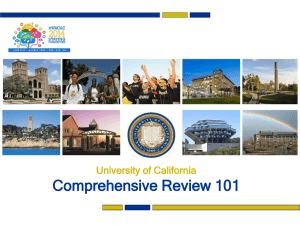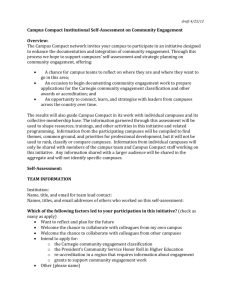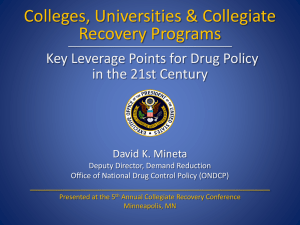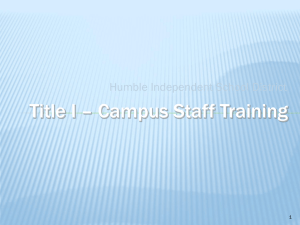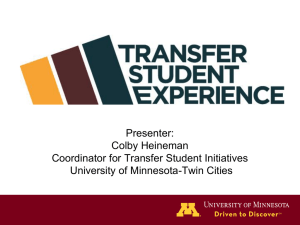Teaching and Learning seminar - First Year in Higher Education
advertisement
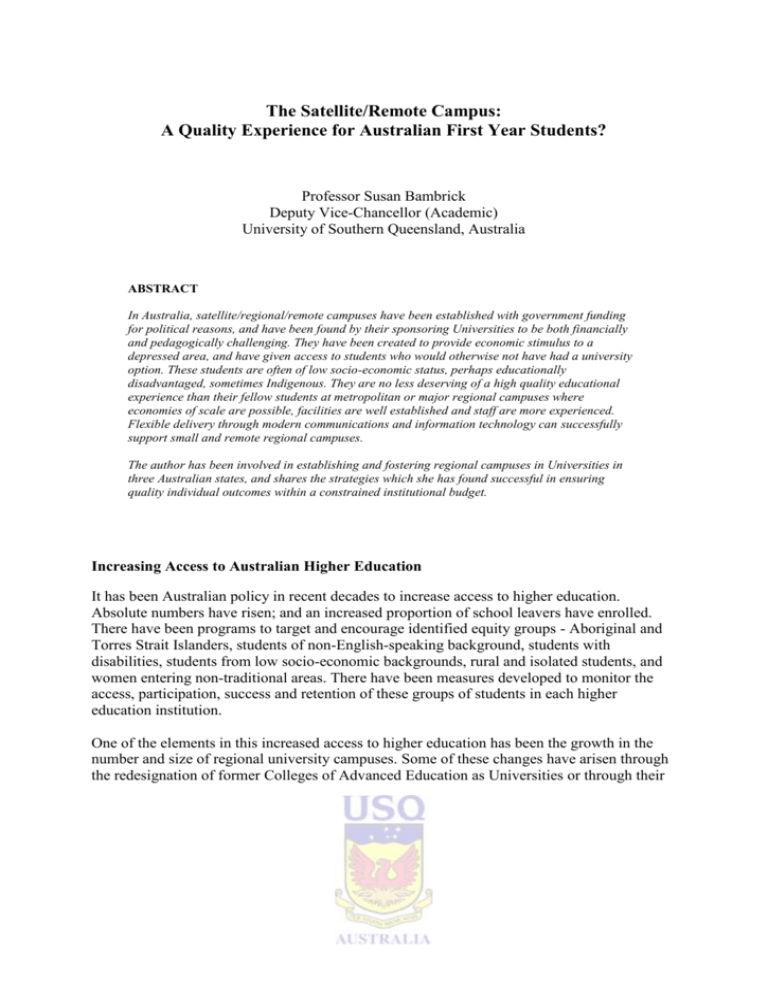
The Satellite/Remote Campus: A Quality Experience for Australian First Year Students? Professor Susan Bambrick Deputy Vice-Chancellor (Academic) University of Southern Queensland, Australia ABSTRACT In Australia, satellite/regional/remote campuses have been established with government funding for political reasons, and have been found by their sponsoring Universities to be both financially and pedagogically challenging. They have been created to provide economic stimulus to a depressed area, and have given access to students who would otherwise not have had a university option. These students are often of low socio-economic status, perhaps educationally disadvantaged, sometimes Indigenous. They are no less deserving of a high quality educational experience than their fellow students at metropolitan or major regional campuses where economies of scale are possible, facilities are well established and staff are more experienced. Flexible delivery through modern communications and information technology can successfully support small and remote regional campuses. The author has been involved in establishing and fostering regional campuses in Universities in three Australian states, and shares the strategies which she has found successful in ensuring quality individual outcomes within a constrained institutional budget. Increasing Access to Australian Higher Education It has been Australian policy in recent decades to increase access to higher education. Absolute numbers have risen; and an increased proportion of school leavers have enrolled. There have been programs to target and encourage identified equity groups - Aboriginal and Torres Strait Islanders, students of non-English-speaking background, students with disabilities, students from low socio-economic backgrounds, rural and isolated students, and women entering non-traditional areas. There have been measures developed to monitor the access, participation, success and retention of these groups of students in each higher education institution. One of the elements in this increased access to higher education has been the growth in the number and size of regional university campuses. Some of these changes have arisen through the redesignation of former Colleges of Advanced Education as Universities or through their amalgamations with Universities, some have arisen through Universities building additional campuses, and some have arisen through the establishment of greenfield institutions. This is usually painted by governments as an equity measure, taking higher education to the people. Sometimes it is even more politically driven, with some “pork barrel” funding provided by governments for marginal electorates/ electorates with high unemployment. Universities are, as one mayor informed me, a highly desirable “clean industry”. These campuses, established with government funding following political pressure, have been found by their sponsoring Universities to be both financially and pedagogically challenging. While the prime if unpublicised reason for their establishment may have been to provide economic stimulus to a depressed area or marginal electorate, they have also given access to students who would otherwise not have had a university option. These students are often of low socio-economic status, perhaps educationally disadvantaged, sometimes Indigenous. They are no less deserving of a high quality educational experience than their fellow students at metropolitan or major regional campuses where economies of scale are possible, facilities may be superior and staff may be more experienced. “Distributed” Universities Australian Universities may be distributed solely within a State, the nation, or both at home and abroad, where they may operate on their own account, through joint arrangements or through agencies. They include campuses, centres, and open learning centres, and may include both traditional distance and online programs. Their establishment in their current forms is a result of their own individual blends of politics, history, geography and economics. I prefer my own term “distributed university” to the term “networked university”, which can be interpreted as an appraisal of achievements in PC use. Electronic connections are important in a distributed university but will not alone give the desired result. The ideal is a single and cohesive institution distributed by happenstance across a variety of locations but functioning as a whole. This ideal is not, of course, always met. Staff on well-established campuses may not immediately and universally embrace the raucous and tiresome but dependent infant. Established academic staff whose quiet and scholarly lives have been disturbed by the very different culture of a newer arm of the institution may resent the “upstarts”, and arrogance may as a result be displayed by both sides. A few metropolitan campus staff may view themselves, with or without reason, as intellectually more sophisticated than their country cousins. They may not want the personal inconvenience of teaching out of town; and they may above all be anxious not to be moved to operate from there, even on a part-time or joint appointment basis. A very important sign of maturity, which cannot happen too soon, occurs when the “satellite” campus becomes a site where some staff want to be housed and from which some courses and other initiatives are generated for the wider University. The progress from derivative to contributing is obviously a great morale booster for staff. It is also highly significant for students, who benefit both directly (through increased public confidence in the recognition of the quality of their campus) and indirectly through high staff morale. Many differences are thinly disguised jealousy about distribution of scarce resources. Those at well-established locations may resent the diversion of funds to provide facilities at greenfields sites. Those at new sites are anxious to establish adequate facilities, services, and real program choice for their new students. Inter-campus tension on resources can be 2 exacerbated by local government and chamber of commerce demands. Community expectations of economic development through campus expansion can be very insistent from the areas housing smaller sections of the operation, while those which are home to larger sections want to keep it that way. The structural tensions in the operation of distributed universities arise from a number of factors. With good leadership, realism, and goodwill from the parties concerned, these tensions do not assume importance. They are not a feature of my life at USQ, but let me outline a few that I am aware can be disruptive. Their ultimate impact is on student learning and they are well worth avoiding. Distance can make collegial discussion more challenging, however much we depend on modern communication. There is still sometimes a need to be in the other place, and the costs of travel and travel time are hopefully balanced by the benefit of personal interaction not only with academic colleagues, but also with the students. For them such visits should add a valued dimension to the learning experience. Where the distribution of administrative power is by location and the distribution of academic power is by discipline, the potential for strain in the system can be easily realized. Where both academic and administrative power reside in one location, there is potential for the other to feel disenfranchised. Where devolution of authority and devolution of responsibility – in the sense of blame- do not coincide there can be further tension. If staff at the regional/satellite campus feel frustrated by the length of the “food chain” or “supply line” this disenchantment is transmitted to students, however inadvertently. In any case students will experience their own difficulties when they seek decisions directly affecting their future. Ensuring speed, consistency, and contextual understanding in dealing with students is vital to their learning environment. Distributed universities, however well adjusted they may be in terms of inter-campus relations, may nevertheless face cost penalties from their multi-site operation, suffering from diseconomies of small scale at one or more locations, and the added costs of duplicated facilities and communication. The distribution of the annual budget is a major operational challenge. Rural and Outer Urban Students Whatever the political, financial and administrative challenges may be, there are students out there in the “regions” (rural or outer urban) wanting to learn. While, as I have said, they are no less deserving of a satisfactory - or even high quality - university experience than students in the city, or at least on the main campus, their experience may be very different. Who are these learners? In a new campus, many of them will typically be the first in their family to go to University. They will often be of relatively low socio-economic status. For rural campuses, they may be from farming families where there is no money and/or perhaps no inclination to send them to the city, at least until they have proved their potential closer to home; or from regional towns where the job market has shrunk. One of the concepts the Australian Government does not seem able to accommodate in its thinking is that students lost from a country campus after first year are not usually drop-outs; they may have demonstrated sufficient success for their families now to be prepared to support them away from home to complete their specialised qualification of first choice, not necessarily available locally. The 3 other fact the Australian Government does not seem able to accommodate is that in the country at least it can be almost impossible to keep IT students into the third year – by the end of second year they have been snapped up by local commercial interests and are on an executive package. The University of Southern Queensland Wide Bay Campus at Hervey Bay has grown rapidly, from 170 students in 1997 to over 1100 registered student library users in 2001. Over half its students are under 20 years of age, with another third aged between 26 and 50. Close to 60% live with their family, with around 35% renting accommodation. 62% are the first member of the family to go to University. Over 90% come from the Wide Bay region. As this region has 23% youth unemployment and 51% Indigenous unemployment, higher education opportunities have especial significance. USQ has a substantial cohort of Indigenous students among those undertaking tertiary preparation studies. In the outer urban campuses of our major cities, some learners will be school leavers and some will be mature age, and a significant proportion of the school leavers may not be ranked at the top of whatever scale is used for tertiary entrance. Mature age learners are likely also to be feeling financial pressures although these will most likely take the form of the mortgage or the low-paid or part-time job (or no job at all) rather than low farm prices. For many of these students there will be family pressures. Some will be women hoping to return to the workforce when their children go to school. Some will be Indigenous Australians, perhaps second chance learners where the first chance was hardly a chance at all. All of these characteristics can also occur amongst students on central campuses, but nevertheless it would appear that the smaller, newer campuses often include a greater concentration of “at risk” learners. Fortunately, at least in the country, they may also feature smaller classes, which helps to overcome some disadvantages. They may also have less experienced staff, who do sometimes however bring an advantage of their own - their student experience may itself be recent, and their enthusiasm is high. One of the more interesting characteristics of newer and smaller campuses can be that their students perform better on average than their main-campus counterparts in the same subjects or units, with the same assessment and common marking. “Remote” Students Students who cannot (or do not want to) attend as on-campus students have long been enrolled as “external”, “distance”, even “correspondence”, and now of course as “online” students. Universities may treat them as remote, though some may live quite close, and may even attend on-campus classes (with or without institutional blessing, as attitudes vary on this). For the most part we think we understand the problems of these “distant” students, their pressures, their drop-out rates and their good achievements when they persist. We support them in their unavoidable or self- inflicted remoteness, be they in Antarctica or Singapore or Cunnamulla or downtown Sydney. Where we provide printed materials, we try to make them attractive, comprehensive, selfsufficient, accurate and reliable, and above all understandable. We take great care with instructional design. Similar requirements apply to online materials. We provide opportunities 4 for interaction – the telephone tutorials, the tutor help line, the online chat sessions, the e-mail enquiries and so on. A distinct group of “remote” students are those studying overseas with agency support. They may be using printed and/or online materials provided by the Australian institution with which they are enrolled, may be meeting regularly for classes, and may be receiving other support from the agency concerned. Some of that class teaching and support, and assessment at least in the early stages of their course, may be in a language other than English. I am not attempting in this paper to discuss issues particular to this group of students. Flexible delivery and “satellite” campuses. When the terms flexible delivery and flexible learning first joined popular educational parlance they meant little more to many people than paper-based distance learning, like the correspondence courses which had been around for some decades, and the way many students had already earned their degrees. Was their experience “second rate”? There on your own, reading the notes instead of having it delivered live, no hearing it all explained, no seeing the rest of the class at least three times a week, library use by post, no browsing amongst the library shelves. Not much chance of discussion (depending on where you lived), no testing understanding against your peers, no solving the problems of the world over coffee, none of the hectic student social life. But there was no travel time, no parking problem, no time wasted on social chit-chat, no need to participate in that hectic social life, no long and pointless personal anecdotes from the lecturer, no sitting through tutorials where people asked silly questions, no wasted hours searching the library catalogue only to find everything relevant was out. If you were an independent adult learner it was an efficient way to qualify so long as the materials were thoughtfully assembled and presented, the content interesting, the assignments challenging, and the feedback informative. It may not have been the experience students wanted at eighteen, but it was tailor-made for motivated and busy nature age students. The “distance” or “online” students now have such a range of interactive options that they should no longer have any reason to see themselves as the poor relations in higher education. This has given some clues as to how satellite campus teaching and learning can be improved. Universities can do more in rural campuses than give an attenuated experience of main campus teaching – these attenuated experiences include the lecture recorded on video, the videoconference, the audio taped classes, the provision of a lecturer to take first year classes strictly in accord with how it would be done on the main campus. The attenuated experiences also include the occasions on an outer urban campus where the visiting lecturer may arrive hot and bothered having coped with the peak hour traffic on the dash from his or her lecture on the main campus; or the experience on a rural campus where the city lecturer arrives, teaches for four hours with a ten minute break, and then disappears for another fortnight. Universities have learned how to transform the unsatisfactory attenuated experience into a productive experience where the students are more involved. They found having a local tutor sit in for the videoconference could be an enormous help, to facilitate local discussion at the end of the session. They learned to make interactive use of technical aids such as “Farsight”. They learned what has proved to be a more productive technique of working online across distances with simultaneous audio. They learned how to make “block teaching” by visitors more effective by building in time for preparation, interaction and reflection. They learned 5 they could make excellent distance materials available to all students, not just supposed “offcampus” students. They learned to make sure all students had adequate on-line capabilities. Students enrolled to study a course face-to-face at a remote campus may, as we have seen, be doing so with distance/online/interactive input from another campus. They may also be adding options to the locally available program by taking external (distance or online) courses from their own or another institution. Even school leavers (who do less well in external mode) find external study in one or two units easier when they are studying face-to face and have a basic routine of participation imposed upon their lifestyle. In general we find at USQ that on campus students perform a little better than off campus students, which is in part reflective of different populations. Online access appears to have a positive impact. Teenagers perform less well than more mature students, especially in offcampus study which requires self-focussing – but the trend seems to be reversed online where younger students are more successful. Location appears insignificant – metropolitan and rural, domestic or overseas, appears to have little impact. Gender is significant, with women on the whole performing better academically than men. The ability to categorise students completely is disappearing. After all, does it matter whether a student is in day mode, or an evening student, or a distance student, a mixed mode student or an online student? Isn’t it much sounder to make available for each student an appropriate range of learning options from which he or she can choose? We are past the stage where we should see “satellite” campus students learning as traditional – if attenuated – main-campus students, with some help from the distance and online sectors. We should now simply see students studying simultaneously by on-campus participation, and/or print-based distance and/or online as desired The USQ Wide Bay Campus optimises the use of communication and information technology in course delivery, offering face-to-face teaching, audio and video assisted small group delivery, interactive videoconferencing, internet connections, interactive whiteboards, fully external delivery and online assistance. We call if The Campus for the Information Age. The range of courses offered through this range of facilities include - business, commerce, humanities, multimedia, informatics (information technology), nursing, tourism and hospitality, and education. From 2002 the Australian Maritime College (centred in Launceston, Tasmania) is joining with USQ Wide Bay to offer its courses in marine resources management and fisheries management. To all students, wherever they are, we need to offer academic support. As in discipline-based courses of study, print and online assistance can substitute for, or supplement, face-to-face assistance according to the learner’s preference. Academic support services, a major function on metropolitan campuses, should be provided in branch campuses as well. Basic and generic assistance can, however, be provided in printed handouts and online to those motivated and able to work in that way. (http://www.usq.edu.au/opacs/learningsupport/index.htm) The extra-curricular experience On a major metropolitan campus there is likely to be an active student body with strong political interests from time to time and a range of activities including debating, participation in competitive sports, and social activities including large-scale entertainment. Life on a 6 country campus may offer a different range of activities but may be equally vibrant and involve a greater proportion of the student population in the valuable experience of organisation and management. At the USQ Wide Bay Campus, for instance, I have fostered the introduction of SIFE (Students in Free Enterprise) which involves students, with a generous time commitment from a business-qualified staff member, in forming an incorporated body to run as a business, raising and spending money for worthwhile causes, networking with an advisory body of local business people. They compete nationally and internationally with similar organizations from other universities, with judges from the corporate sector. Conclusion Country campus and outer urban campus experiences are different from the metropolitan campus life enjoyed by some students; but they are no less valid. As a University experience they can be just as intellectually stimulating, with access to well-qualified staff, state of the art technology and access to global information resources. Non-metropolitan campuses offer chances for personal development within a supportive community. March 2002 7

